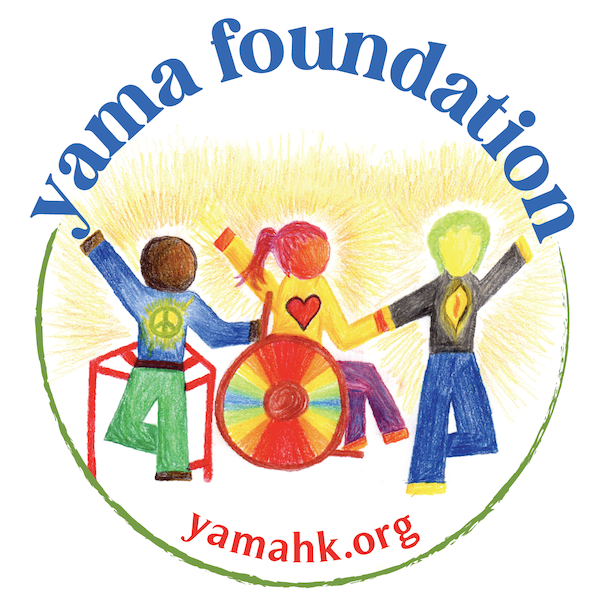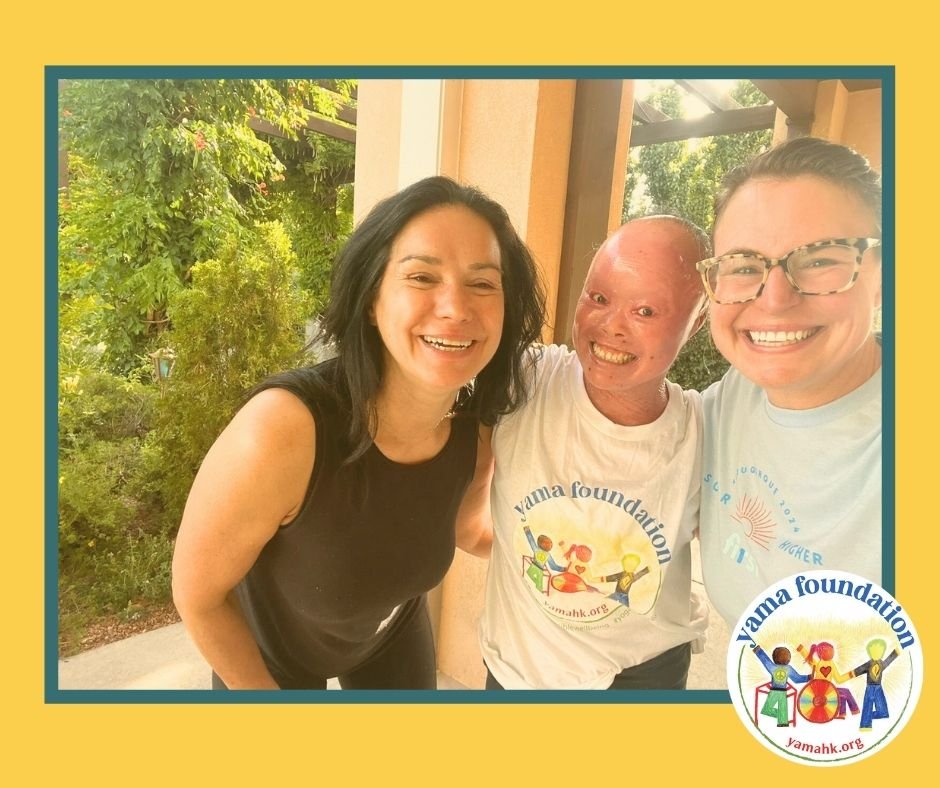Mui Thomas: Teaching Yoga to Those Like Me 給與我相同的人教授瑜伽
On 28 June 2024, Mui Thomas reached a significant milestone in her life. She led a YAMA Foundation Accessible Yoga class for others with Ichthyosis, the skin condition she herself has lived with since birth. “It was a full circle moment for me,” she said. “A moment that was five years in the making.”
Mui Thomas is a certified yoga instructor, L1MO World Rugby Referee, public speaker, YAMA Foundation ambassador, and a really fun person to be around. We interviewed her to get the full story of what that yoga class meant to her and her students, and what it took to reach this significant milestone.
How did you come to teach yoga for other survivors of Ichthyosis in the USA this year?
Mui: Every two years, there is a conference held by FIRST (Foundation for Ichthyosis & Related Skin Types) in the USA. This year, there was a focus on wellbeing and I wanted to teach a yoga class as part of the conference.
I’ve been involved with YAMA Foundation for 5 years now, and right from the very beginning, Hersha told me, “How great would it be for you to hold classes for others with Ichthyosis.” I had taught a few classes online during the pandemic with another yoga instructor who has Ichthyosis. This led me to wonder if it would be possible to teach a class at the conference in Albuquerque, New Mexico this year. We put our heads together and made it happen.
Hersha and I had regular practice sessions together beforehand, where I honed my skills and got feedback and mentoring. We decided that this conference was a great opportunity to integrate my role as a YAMA Ambassador as well.
This trip ended up being a very challenging experience on many levels. But teaching the yoga class was a definite highlight.
What was it like, leading this yoga class?
Mui: It was both very challenging and rewarding. I’ll summarise here:
The challenges:
The environment. We were in the desert - probably the toughest environment for people with Ichthyosis, because we cannot sweat properly and we need to stay super hydrated at all times. As an extra challenge, the venue forgot to unlock the doors for our 7am class so we had the class on an outdoor patio. Not ideal.
The range of abilities. Of the 13 people who attended, more than half had different types of Ichthyosis, plus there was a pregnant lady, a person with sight and hearing difficulties, and a person with limited mobility - the whole spectrum of abilities! It was if the universe had sent me an opportunity to put all my training to use in one single class! Since I didn’t know who was attending until the start of the class, I had to design a multi-level accessible class on the spot. It was a challenge of epic proportions.
The stakes. It’s weird because I don’t usually get nervous when teaching yoga. But this class terrified me. The stakes are higher, there’s more uncertainty about what the students can and cannot do, and there’s so much more to consider. I really had no idea what I was dealing with until the class started, so there was a LOT of adjusting as I went along. Even though I had done a lot of preparation, I panicked for the first few minutes, thinking, “I’m too jet-lagged for this.” I calmed myself with some breathing techniques and told myself to just do my best. That’s all I can do.
The wins:
The shared experience. Normally, I’d prefer to give one-to-one classes, tailored to each person. But there is something magical about doing yoga together with others like you. You get proof that you’re not alone. And being able to give that feeling to someone is worth all the extra effort.
The support. First of all, I had Hersha and YAMA Foundation rooting for me to do this and cheering me on from Hong Kong. And during the class itself, I wasn’t alone. My assistant teacher Sacha was by my side, helping with adjustments for every student. I’m so grateful to her for supporting me and letting me lead in my own style. I did the same for her class the next day.
Serving my community. It was amazing to support others with Ichthyosis in this way. And to support the wider community of people with physical and cognitive differences. Representation is important for building self-acceptance. From my students’ feedback, I saw how impactful it was to have a teacher who looked like them, with the same lived experience, leading a class in public.
“It meant the world to show them - not just tell them - that if I can do this, they can do anything. ”
How did you get into yoga?
Mui: I hated the first yoga class I went to. I was used to the rugby world, so yoga felt like a total mis-match. Yoga was never part of the plan.
I met Hersha when I was looking for work, and she offered me a training opportunity. She knew my background in sport and suggested teaching yoga as a way to support my community. My first thought was, “No, no, no, that’s not happening.” But slowly, I started to see how beneficial yoga is. The rugby world is about being tough and pushing yourself to (and often past) the limit. Yoga (depending on the style) offers a much needed balance to that.
I’ve been gradually finding my niche as a yoga teacher. I work with rugby players, as we are notoriously in need of a good stretching session. But mainly, I teach people who don’t feel confident in a yoga studio for whatever reason.
There are so many people who feel self-conscious or out of place in a yoga class. The more perfectionistic yoga has become, the more exclusive it has become. There is a lot of fear that keeps people out of yoga studios. Fear of not being able to keep up or do a handstand. Fear of being stared at or judged.
“I stand for everyone who just wants to practise yoga without being fat-shamed or skin-shamed or ability-shamed. ”
My classes are free of judgment and perfectionist ideals. Just come as you are, because isn’t that the real spirit of yoga anyway?
And I’m grateful to Hersha and YAMA Foundation for leading the way for inclusivity and accessibility in the Hong Kong yoga scene. Currently, we’re raising funds to open an Accessible Wellness Centre, and when it opens, I’ll 110% be there!
What is your own yoga practice teaching you?
Mui: Yoga is teaching me how to honour my own body and be okay with what I can and cannot do.
No two practices are the same. What looks like a practice to one, might not look like much to the other. But it is still a practice.
I need to practise what I preach because occasionally I have been known to not honour my own abilities or I push participants slightly past what they can do because deep down, I still have a slightly perfectionist mentality on how something should look. Still learning!
What would you say to others with different abilities who want to step out into a leadership role?
Mui: Whatever you want to do (it doesn’t have to be teaching yoga), you can be an inspiration! Here are some things I am learning in my journey that I’d like to share with you:
Hone your skill. People with different abilities still have to put in the work to offer something valuable to their community. Whatever your goal is, don’t do it simply because you tick a diversity box. You want to do it because you’ve earned it. Remember, it’s not about you, it’s about them, and they deserve a great experience.
Fear is normal. It’s terrifying to put yourself out there. Even people without these conditions feel fear when stepping out in front of others. Expect the fear, feel the fear, take a deep breath and do it anyway.
Ask for help. I didn’t do this class alone. I had people supporting me at every stage. I had to be vulnerable to reach out, but that’s how you leap hurdles: with the support of your community lifting you up. And hey, once you’ve put yourself out there, you’ll be surprised by how many people will show up and support you. It’s amazing.
How can Hong Kong become a more accepting and inclusive society?
Mui: I understand that many people feel anxious when interacting with someone with a disability, but before you lash out, ask yourself, “Is this person doing their best?”. That’s all it comes down to in the end.
We’re not asking you to roll out the red carpet for us. We simply ask you to understand that we’re doing our best.
____
ABOUT MUI THOMAS
Mui Thomas is one of the world's oldest survivors of Harlequin Ichthyosis, a rare genetic skin condition that causes thickened skin over the entire body.
Due to her skin condition, she has overcome Olympic-level hurdles of discrimination, prejudice, abuse, unwanted curiosity, hatred, cyberbullying, mental health issues and ultimately survival. You can read more about Mui’s story though the “The Girl Behind The Face” Initiative that her parents set up.
Follow Mui on Instagram and read more about her journey with YAMA Foundation here.
Mui Thomas: 給與我相同的人教授瑜伽
2024年6月28日,Mui Thomas 踏上人生中的一個重要里程碑。她為一羣斑色魚鱗癬症患者帶領了一堂 YAMA 基金會的無障礙瑜伽班,這病症是她自出生以來就患有的罕見皮膚病。“這對我來說是"走了完整一圈"的時刻,” 她說。“一個醞釀了五年的一刻。
Mui Thomas是一位認證的瑜伽教練,L1MO世界橄欖球裁判,公眾演講者,YAMA基金會大使,也是一個非常有趣的人。我們訪問了她,以瞭解她帶領的那堂瑜伽班對她和她的學生來說意味著什麼,以及要達到這一重要里程碑當中需要什麼。
今年,妳是怎麼開始為美國其他魚鱗病倖存者教授瑜伽的?
Mui: FIRST(魚鱗病及相關皮膚類型基金會)在美國舉行每兩年一度的會議。他們今年的主旨是關注身心福祉,因此我想會議當中帶領一節瑜伽堂。
我與 YAMA 基金會已經有 5 年的合作關係了,從一開始 Hersha 便告訴我說,“我的目標是讓妳為其他患有魚鱗病的人開設課程。在疫情期間,我曾在網上教授另一位患有魚鱗病的瑜伽教練。這讓我在想是否有可能在今年於新墨西哥州阿爾伯克基的會議上帶領一堂。我們集思廣益,實現了它。
Hersha 和我事前定期一起練習,把我的瑜伽技能加以磨練,從中並獲得了反饋和指導。我們認為這次會議給予我這個 YAMA 大使的角色一個絕佳的機會。
帶領這堂瑜伽時,感覺如何?
Mui: 這既非常具有挑戰性,同時也很有意義。我在這裏總結一下:
挑戰:
環境: 我們在沙漠中 - 對於魚鱗病患者來說可能是最惡劣的環境,因為我們無法正常出汗,皮膚必需要每刻保持水分充足。此外,場地忘記為我們早上 7 時的課堂解鎖門,所以我們不得不在戶外的露台上練習。並不理想。
參加者能力差異:在參加的 13 人中,超過一半的人患有不同類型的魚鱗病。此外還有一位孕婦、一位有視力和聽力障礙,以及一位行動不便的人——各層次的能力界限!就好像宇宙給了我一個機會,讓我把所學過的訓練都運用在這一堂裏!由於課堂開始時才與學生第一次見面,所以我必需在當時絞盡腦汁設計一個多層次的無障礙課堂。真是一個前所未有的挑戰。
風險:奇怪的是,我在教瑜伽時通常不會感到緊張。但是這門課嚇壞了我。風險極高,學生們的能力的不確定性非常大,而且需要考慮的因素還有很多。不到課堂開始時,我真的不知道自己會面對到什麼,所以在過程中有很多調整。儘管我已經做了很多準備,但最初的幾分鐘我還是驚慌失措,心想:“我太倒時差了”。我用一些呼吸技巧讓自己平靜下來,並告訴自己要盡力而為。這就是我能做的。
收穫:
分享體驗. 通常,我較喜歡教授給學生度身訂做一對一課程。但是,跟與你相同情況的人一起做瑜伽又另有一番奇妙的感受。你得到了證明你並不孤單。能夠給他人這種感覺,所有額外的努力都是值得的。
支持. 首先,我得到 Hersha 和 YAMA 基金會的支持和鼓勵,並在香港為我打氣。在課堂上,我並不感到孤單。我的助理老師 Sacha 在我身邊,幫助每個學生進行適當調整。我非常感謝她的支援,讓我能以自己的風格引領。第二天,我為她帶領的課堂作出同樣的支援。
為我的羣組服務. 以這種方式支援其他魚鱗病患者真是太棒了。並為更廣泛有身體和認知差異的羣組提供支援。”代表性”對於建立自我接納相當重要。從本次活動學生的反饋中,我看到了有一位長得像他們、有著相同生活經歷的老師在公共場合帶領課堂是多麼有影響力。這意味著向他們展示 - 而不僅僅是告訴他們 - 如果我能做到這一點,他們就可以做任何事情。
你是怎麼開始接觸瑜伽的?
Mui: 我討厭我的第一堂瑜伽課。當時已經習慣了橄欖球世界,所以瑜伽感覺完全不匹配。瑜伽從來都不是任何計劃的一部分。
我在找工作時遇到了 Hersha,她提議給我一個培訓機會。她瞭解我的體育背景並建議我以教授瑜伽以支援我的社羣。我當時第一個想法是:”不,不,不,這絕不會發生的。” 但慢慢地,我開始看到瑜伽的益處。
橄欖球世界就是要堅強,把自己推向極限(而且經常超越極限)。 瑜伽(取決於風格)為此提供了必需的平衡。
我逐漸找到了自己作為瑜伽老師的定位。 我和橄欖球運動員一起工作,眾所周知,他們都需要良好的伸展練習。 但主要的,是我教的是那些因為各種原因在瑜伽室裏不感到自信的人。
有很多人在瑜伽課上感到不自在或格格不入。 瑜伽變得越完美主義,亦變得更難接觸。有很多恐懼因素讓人們遠離瑜伽室,例如害怕無法跟上或倒立。 害怕被盯著看或被評判等。
我支持每一位只想練習瑜伽而不被批判肥胖、皮膚或能力的人。我的課堂沒有批判和完美主義的主意。隨著你的本色到來吧,因為這就不是瑜伽的真正精神嗎?
我感謝 Hersha 和 YAMA 基金會在香港瑜伽界引領包容和可及性。目前,我們正在籌集資金開設一個無障礙健康中心,當它開放時,我將 110% 在那裡!
你自己的瑜伽練習教會了你什麼
Mui: 瑜伽教我如何尊重自己的身體,並接受我的所能和所不能。
每次練習都是不一樣的。對某人來說看起來像是一種的練習,對另一個人來說可能看起來沒什麼意義。但這仍然是一種實踐。
我需要言傳身教,有時人們會知道我不尊重自己的能力,或者我把參與者稍微推得超出了他們的能力範圍,因為在內心深處,我對事物應該是什麼樣子仍然有一種略帶完美主義的心態。還在學習中!
你會對那些有着不同能力、想要走上領導崗位的人説些什麼?
Mui: 無論你想做什麼(不一定是教瑜伽),你都可以成為一個靈感!以下想與大家分享我在旅程中學到的一些東西:
磨練你的技能. 儘管具有不同能力,仍然必須投入工作,為社羣提供有價值的貢獻。無論你的目標是什麼,都不要僅僅因為你勾選了多樣性框。你想做是因為你努力爭取得到。請記住,這不是關於你,而是關於他們,他們應該得到很好的體驗。
感到恐懼是正常的. 要放膽走在人羣之前是會感到可怕的。即使對沒有像我這狀況的人來說,要走在別人面前時也會感到恐懼。接受恐懼,感受恐懼,深吸一口氣,然後繼續往前走。
勇於求助. 這課堂不是我單刀匹馬完成的。在每個階段都有人支援我。我必須適當時候放下自我讓他人伸出援手,但這就是你跨越障礙的方式:在你的社羣的支援下你得到了提升。當你發聲求助時,你會驚訝地發現有原來有這麼多人會出現並支持你。是很神奇的。
香港能如何變成一個更包容和共融的社會?
Mui: 我理解很多人在與殘疾人互動時會感到焦慮,但在你抨擊他們之前,可問問自己,“以這個人的能力許可下,是否已經盡了力呢?” 這就是最終的主旨。
我們不是要你為我們鋪紅地毯。我們只是想讓你明白我們正在盡最大努力。
____
關於 MUI THOMAS
Mui Thomas 是世界上最年長的斑色魚鱗癬症倖存者之一,這是一種罕見的遺傳性皮膚病,會導致全身皮膚增厚。
由於她的皮膚狀況,她克服了歧視、偏見、虐待、不懷善意的好奇心、仇恨、網絡欺淩、心理健康問題以及最終生存等奧運級障礙。 你可以透過由 Mui 父母發起的 “The Girl Behind The Face” Initiative 來瞭解更多關於她的故事。
在 IG 中關注 Mui,並在這裡閱讀更多關於她與YAMA基金會的旅程。





